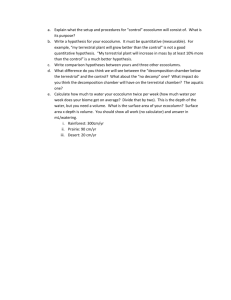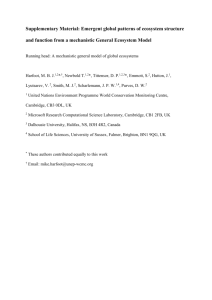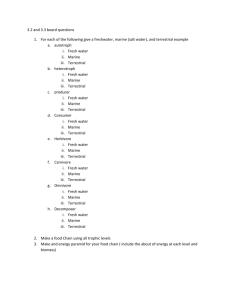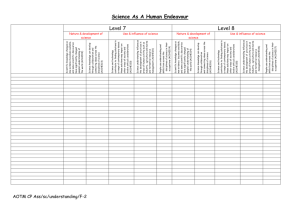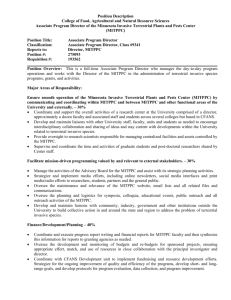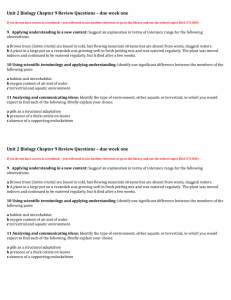UK Biodiversity Indicators 2015
advertisement
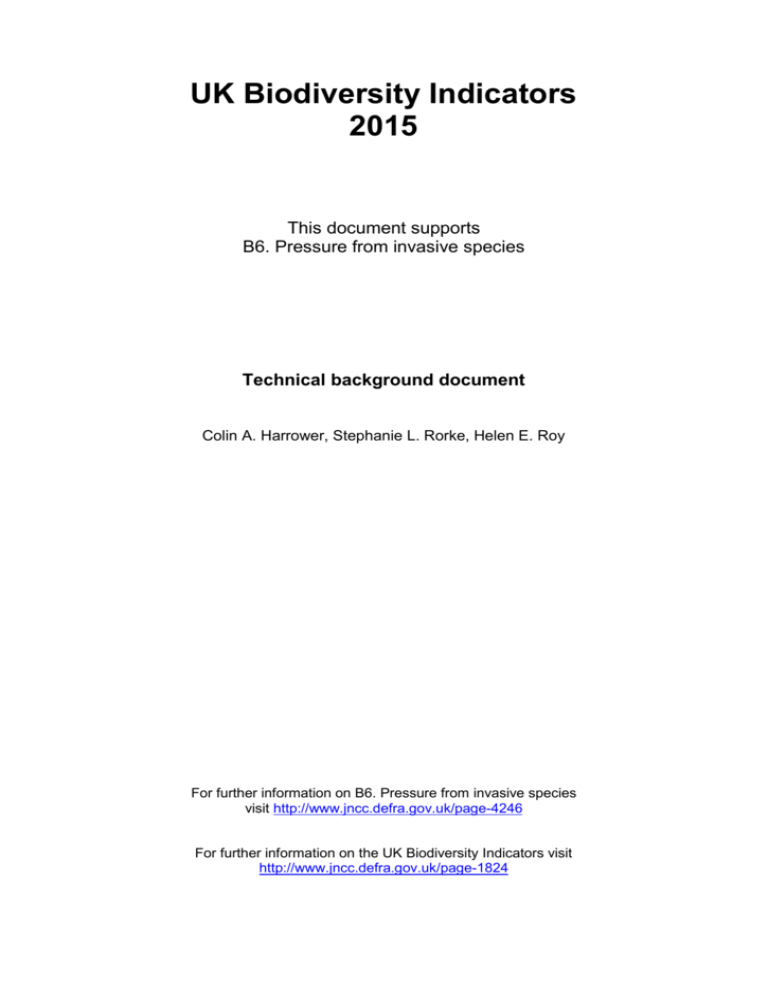
UK Biodiversity Indicators 2015 This document supports B6. Pressure from invasive species Technical background document Colin A. Harrower, Stephanie L. Rorke, Helen E. Roy For further information on B6. Pressure from invasive species visit http://www.jncc.defra.gov.uk/page-4246 For further information on the UK Biodiversity Indicators visit http://www.jncc.defra.gov.uk/page-1824 B6. Pressure from invasive species – technical document – December 2015 Colin A. Harrower, Stephanie L. Rorke, Helen E. Roy Overview There are 180 established invasive non-native species in Great Britain and included within the indicator. In 2014 a two stage process was used to produce the indicator, with initial assessments for each of the invasive non-native species being produced by statistical analyses using occurrence data available through the NBN Gateway which are then in turn validated and modified, where required, by experts. The statistical method used aimed to control for some of the issues with the incomplete nature of the occurrence data and allow the extent of occurrence of each species to be calculated. Expert validation and modification was required due to inadequacies in the data, particularly for the earlier and most recent time periods. In 2015 the species list and the classification of extent (derived for the 2014 indicator) were reviewed and updated by taxonomic experts. Species list In 2014 the species included within the indicator was substantially expanded from the 49 species used in the previous indicator. A preliminary list was produced from the GB Nonnative Species Information Portal (GB NNSIP) by selecting all species in the database that were designated as having negative or strongly negative ecological effect. The information on impacts within the GB-NNSIP is not based on quantitative assessment but was a rapid assessment relying on expert opinion. Therefore, it was deemed necessary to review the initial list, again using expert opinion. In 2015 only one species was added (a clam, Rangia cuneata) and none were removed from the list. Update and review in 2015 In 2015 the modelling was not repeated and taxonomic experts referred to relevant occurrence data holdings to update the classification of extent. Terrestrial and freshwater plant species were subject to extensive review using additional data holdings available through the Botanical Society of Britain and Ireland (BSBI). The model outputs were viewed by BSBI experts and the extent scores adjusted if the botanical experts considered if the extent of occupancy should be refined. This resulted in changes to the classification of 48 plant species across all decades with 27 of these plant species with amendments in the last decade; mainly decreases in extent but with one species (Egeria densa) assigned an increase in extent over one decade. Three plant species were considered to have decreased in extent by two categories within the classification. Consequently the overall change to the indicator is a decrease in extent classification. Data used in analyses – 2014 only The occurrence data used in the statistical analyses conducted in 2014 were obtained from the National Biodiversity Network (NBN) Gateway, downloaded in October 2014. The analysis used all data that were publicly available from the NBN Gateway having a minimum resolution of 10km. The extracted occurrence data were divided into 10 year time slices to enable the areas of extent to be calculated independently for each decade. To be included in a dataset the start date and end date of a record needed to fall within the respective time period, therefore records which span one or more time periods were excluded. Analytical estimation of Area of Extent (AoE) – 2014 only The process used to calculate the area of extent is based upon the approach recently used to develop the England Vascular Plant Red List (Stroh et al. 2014). Three different methods were used to determine extent of occurrence; (1) determining the number of distinct 10km squares the species has been recorded within and then calculating the total area of these 10km squares; (2) the Minimum Convex Polygon (MCP); and (3) the alpha hull. The first of these methods involves determining for each decade the number of distinct OSGB 10km squares that contained occurrence data for each species and then the total area was obtained by summing the area of these 10km squares. The second method involved calculating the MCP for the occurrence data for each decade. The MCP is defined as the smallest polygon in which no internal angle exceeds 180 degrees and which contains all the sites of occurrence. The MCP is often criticised due to the tendency for non-suitable areas to be included within the shape, especially when fitted to areas in which there are large areas of unsuitable habitat surrounded by suitable habitat. To reduce the extent to which this problem affected the areas estimated, a secondary polygon was created by intersecting the MCP polygon with the land mass of Great Britain (or a 50km wide coastal region in the case of marine species) and the area (in km2 and also as a percentage of the total land/marine buffer area of Great Britain) of this polygon was then calculated. The third method fitted an alpha hull to the occurrence data for each decade. Alpha hulls are a generalisation of the convex polygon and have been suggested to be more suitable to species distributions than Minimum Convex Polygon, especially for irregularly shaped species ranges (Burgman & Fox 2003). Alpha hulls are created by a Delaunay triangulation of the data points (joining all points so that no lines intersect between points) and then selectively removing lines from this triangulation based on the value of a parameter α. The smaller the value of α the finer the resolution of the hull produced. As α increases the alpha hull will approach the MCP. There is no ideal value of α, rather the choice depends upon the quality of the data and the aims of the study. For the indicator analyses an α value of 80,000 was used. In order to minimise the inclusion of unsuitable habitat the alpha hull was also intersected with the land mass of Great Britain (or 50km wide coastal region for marine species) to produce a new hull for which the area (in km2 and also as a percentage of total land/marine buffer area of Great Britain) was calculated. Expert validation & modification – 2014 only A series of maps and area estimates was produced for each invasive non-native species from these analyses. An example of the maps produced, in this case Elodea canadensis, is given in Figure 1 below. Figure 1 Example area of extent maps for Elodea canadensis using data from the 1970-1979 time period. The first map shows the 10km occurrence data, the second map shows the Minimum Convex Polygon (outlined by a red line) and its intersection with the land (green filled region) and third map shows the alpha hull (outlined by a red line) and its intersection with the land (green filled region). The labels above each map give the total area of distinct 10km squares, the area of the MCP/GB land intersection and the area of the alpha hull/GB land intersection respectively. The species maps and area estimates were circulated to the relevant taxonomic or environmental experts along with a spreadsheet containing initial classifications, within the four extent categories used in B6ii, of the decadal distributions for each species. The initial classification was achieved using the area estimates from the alpha hull / GB intersection polygon because this resulted in the most conservative estimates which provided a guide for the experts. Experts were asked to review the maps and area estimates, alongside any additional data sources available to them where relevant, to determine whether the classification in the spreadsheet represented an accurate picture of the species distribution for each decade. Where the experts deemed a category value to be a poor representation they were asked to modify the category to the value they considered to accurately reflect the extent. It is these expert modified classifications of extent that were used in final figures present in the indicator. Invasive non-native species included Environment Common Name Scientific name Marine a bryozoan Schizoporella japonica Marine a bryozoan Tricellaria inopinata Marine a bryozoan Watersipora subatra Marine a coelenterate Cordylophora caspia Marine a crustacean Dyspanopeus sayi Marine a mollusc Ensis directus Marine a mollusc Mytilopsis leucophaeata Marine a tunicate Botrylloides diegensis Marine a tunicate Botrylloides violaceus Marine a tunicate Corella eumyota Marine a tunicate Didemnum vexillum Marine algae Bonnemaisonia hamifera Marine algae Grateloupia turuturu Marine algae Heterosiphonia japonica Marine algae Neosiphonia harveyi Marine American sting winkle Urosalpinx cinerea Marine an acorn barnacle Austrominius modestus Marine an amphipod Monocorophium sextonae Marine an amphipod Gammarus tigrinus Marine an annelid Ficopomatus enigmaticus Marine an annelid Hydroides elegans Marine an annelid Hydroides ezoensis Marine Chinese mitten crab Eriocheir sinensis Marine compass sea squirt Asterocarpa humilis Marine dwarf crab Rhithropanopeus harrisii Marine green sea fingers Codium fragile subsp.fragile Marine harpoon weed (algae) Asparagopsis armata Marine Japanese kelp, wakame Undaria pinnatifida Marine Japanese skeleton shrimp Caprella mutica Marine leathery sea squirt Styela clava Marine Pacific oyster Crassostrea gigas Marine slipper limpet Crepidula fornicata Marine swim-bladder nematode Anguillicoloides crassus Environment Common Name Scientific name Marine wire weed Sargassum muticum Freshwater a mollusc Corbicula fluminea Freshwater a mollusc Rangia cuneata Freshwater a polychaete Hypania invalida Freshwater African clawed frog Xenopus laevis Freshwater American bullfrog Lithobates catesbeianus Freshwater bloody-red mysid Hemimysis anomala Freshwater Canadian waterweed Elodea canadensis Freshwater curly waterweed Lagarosiphon major Freshwater demon shrimp Dikerogammarus haemobaphes Freshwater duck-potato Sagittaria latifolia Freshwater floating pennywort Hydrocotyle ranunculoides Freshwater goldfish Carassius auratus Freshwater Italian alpine newt Icthyosaura alpestris Freshwater Italian crested newt Triturus carniflex Freshwater Jenkins' spire snail Potamopyrgus antipodarum Freshwater killer shrimp Dikerogammarus villosus Freshwater large-flowered waterweed Egeria densa Freshwater least duckweed Lemna minuta Freshwater marsh frog Pelophylax ridibundus Freshwater New Zealand pigmyweed Crassula helmsii Freshwater Northern river crangonyctid Crangonyx pseudogracilis Freshwater Nuttall's waterweed Elodea nuttallii Freshwater parrot's feather Myriophyllum aquaticum Freshwater pumpkinseed Lepomis gibbosus Freshwater quagga mussel Dreissena bugensis Freshwater rainbow trout Oncorhynchus mykiss Freshwater red swamp crayfish Procambarus clarkii Freshwater signal crayfish Pacifastacus leniusculus Freshwater spinycheek crayfish Orconectes limosus Freshwater sunbleak Leucaspius delineatus Freshwater topmouth gudgeon Pseudorasbora parva Freshwater Turkish crayfish Astacus leptodactylus Freshwater Ludwigia grandiflora Freshwater Uruguayan hampshirepurslane virile crayfish Freshwater water fern Azolla filiculoides Freshwater wels catfish Siluris glanis Freshwater white river crayfish Procambarus acutus Freshwater zander Sander lucioperca Freshwater zebra mussel Dreissena polymorpha Terrestrial a flatworm Australoplana sanguinea Terrestrial a flatworm Kontikia ventrolineata Terrestrial aesculapian snake Zamensis longissimus Orconectes virilis Environment Common Name Scientific name Terrestrial alexanders Smyrnium olusatrum Terrestrial American mink Mustela vison Terrestrial American skunk-cabbage Lysichiton americanus Terrestrial an ant Lasius neglectus Terrestrial arrow bamboo Pseudosasa japonica Terrestrial Austrian pin Pinus nigra Terrestrial bear's-breech Acanthus mollis Terrestrial berberis sawfly Arge berberidis Terrestrial Bermuda-buttercup Oxalis pes-caprae Terrestrial biliary parasite Pseudamphistomum truncatum Terrestrial Billard's bridewort Spiraea alba x douglasii = S. x billardii Terrestrial black rat Rattus rattus Terrestrial black-bindweed Fallopia convolvulus Terrestrial bladder-senna Colutea arborescens Terrestrial blotched monkey flower Mimulus luteus Terrestrial bluebell Terrestrial Brazilian giant-rhubarb Hyacinthoides non-scripta x hispanica = H. x massartiana Gunnera manicata Terrestrial bridewort Spiraea salicifolia Terrestrial broad-leaved bamboo Sasa palmata Terrestrial brown rat Rattus norvegicus Terrestrial Buddleia Buddleja davidii Terrestrial Canada goose Branta canadensis Terrestrial Canadian goldenrod Solidago canadensis Terrestrial cherry laurel Prunus laurocerasus Terrestrial common michaelmas-daisy Aster novi-belgii x lanceolatus = A. x salignus Terrestrial common wall lizard Podarcis muralis Terrestrial confused bridewort Terrestrial dump fly Spiraea salicifolia x douglasii = S. x pseudosalicifolia Hydrotaea aenescens Terrestrial Dutch rose Rosa ‘Hollandica’ Terrestrial eagle owl Bubo bubo Terrestrial Eastern gray squirrel Sciurus carolinensis Terrestrial edible dormouse Glis glis Terrestrial Egyptian goose Alopochen aegyptiacus Terrestrial entire-leaved cotoneaster Cotoneaster integrifolius Terrestrial European rabbit Oryctolagus cuniculus Terrestrial evergreen oak Quercus ilex Terrestrial fallow deer Dama dama Terrestrial false-acacia Robinia pseudoacacia Terrestrial feral cat Felis catus Terrestrial feral goat Capra hircus Terrestrial ferret Mustela furo Terrestrial few-flowered garlic Allium paradoxum Terrestrial garden lady's-mantle Alchemilla mollis Terrestrial giant hogweed Heracleum mantegazzianum Environment Common Name Scientific name Terrestrial giant knotweed Fallopia sachalinensis Terrestrial giant-rhubarb Gunnera tinctoria Terrestrial great brome Anisantha diandra Terrestrial green alkanet Pentaglottis sempervirens Terrestrial hairy bamboo Sasaella ramosa Terrestrial harlequin ladybird Harmonia axyridis Terrestrial heath star moss Campylopus introflexus Terrestrial Himalayan balsam Impatiens glandulifera Terrestrial Himalayan cotoneaster Cotoneaster simonsii Terrestrial Himalayan knotweed Persicaria wallichii Terrestrial horse chestnut scale Pulvinaria regalis Terrestrial hottentot-fig Carpobrotus edulis Terrestrial house mouse Mus domesticus Terrestrial Japanese knotweed Fallopia japonica Terrestrial Japanese rose Rosa rugosa Terrestrial juneberry Amelanchier lamarckii Terrestrial late michaelmas-daisy Aster laevis x novi-belgii = A. x versicolor Terrestrial lesser knotweed Persicaria campanulata Terrestrial lesser periwinkle Vinca minor Terrestrial mandarin duck Aix galericulata Terrestrial maritime pine Pinus pinaster Terrestrial monk parakeet Myiopsitta monachus Terrestrial montbretia Crocosmia aurea x pottsii (C. x crocosmiiflora) Terrestrial Aster lanceolatus Terrestrial narrow-leaved michaelmasdaisy New Zealand flatworm Terrestrial oak processionary Thaumetopoea processionea Terrestrial pheasant Phasianus colchicus Terrestrial pirri-pirri-bur Acaena novae-zelandiae Terrestrial pitcherplant Sarracenia purpurea Terrestrial plant hybrid Fallopia japonica x sachalinensis = F. x bohemica Terrestrial Portugal laurel Prunus lusitanica Terrestrial potato aphid Macrosiphum euphorbiae Terrestrial purple dewplant Disphyma crassifolium Terrestrial red-legged partridge Alectoris rufa Terrestrial red-osier dogwood Cornus sericea Terrestrial Reeve's muntjac Muntiacus reevesi Terrestrial rhododendron Rhododendron ponticum Terrestrial rhododendron leafhopper Graphocephala fennahi Terrestrial rose-ringed parakeet Psittacula krameri Terrestrial rosy garlic Allium roseum Terrestrial ruddy duck Oxyura jamaicensis Terrestrial rum cherry Prunus serotina Terrestrial russian-vine Fallopia baldschuanica Terrestrial shallon Gaultheria shallon Arthurdendyus triangulatus Environment Common Name Scientific name Terrestrial sika Cervus nippon Terrestrial snowberry Symphoricarpos albus Terrestrial spartina planthopper Prokelisia marginata Terrestrial Spiraea Spiraea Terrestrial steeple-bush Spiraea douglasii Terrestrial thorn-apple Datura stramonium Terrestrial tree-of-heaven Ailanthus altissima Terrestrial Turkey oak Quercus cerris Terrestrial Virginia-creeper Parthenocissus quinquefolia Terrestrial wall cotoneaster Cotoneaster horizontalis Terrestrial water deer Hydropotes inermis Terrestrial Western green lizard Lacerta bilineata Terrestrial white butterbur Petasites albus Terrestrial winter heliotrope Petasites fragrans Terrestrial wireplant Muehlenbeckia complexa Terrestrial yellow archangel Lamiastrum galeobdolon subsp. argentatum References Burgman, M.A., & Fox, J.C. (2003) Bias in species range estimates from minimum convex polygons: implications for conservation and options for improved planning. Animal Conservation, 6(01), 19–28. Stroh, P.A., Leach, S.J., August, T.A., Walker, K.J., Pearman, D.A., Rumsey, F.J., Harrower, C.A., Fay, M.F., Martin, J.P., Pankhurst, T., Preston, C.D. & Taylor, I. (2014) A Vascular Plant Red List for England. Botanical Society of Britain and Ireland, Bristol.
